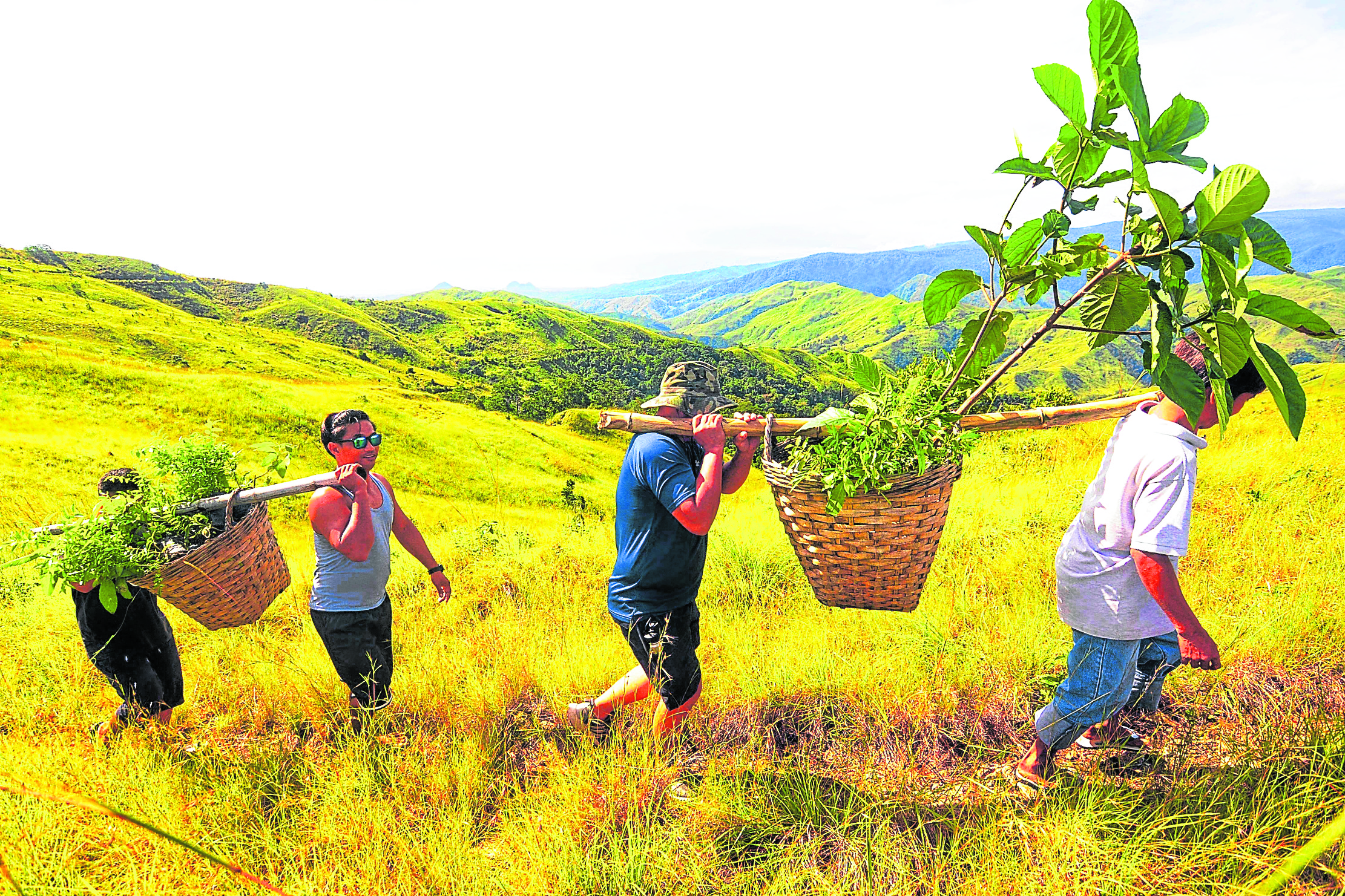
GREEN CAMPAIGN Members of the Pangasinan Native Trees Enthusiasts (PangNTE), volunteers and government employees bring saplings of native trees to Daang Kalikasan in Mangatarem, Pangasinan, during a tree planting activity on June 25 last year. —WILLIE O. LOMIBAO
CALASIAO, PANGASINAN — At least 2,500 saplings and seedlings of native trees in the mountains of Mangatarem town in this province have also suffered from extremely high temperatures in the past few weeks.
This was discovered by a group of native tree enthusiasts who went to Daang Kalikasan in Mangatarem on April 13 to water the trees they had planted over the past three years in a 20-hectare deforested area.
READ: In Pangasinan, ‘love affair’ with native trees blooms
Celso Salazar, head of the Pangasinan Native Tree Enthusiasts (PangNTE), said 100 members of the group trekked to Daang Kalikasan, carrying water jugs to hydrate the young trees.
Salazar said their goal was to help the trees survive the prolonged dry spell.
“Sadly, about half of the 5,000 seedlings did not survive the heat and have withered,” Salazar told the Inquirer.
He said the seedlings, or those that are about 1.5 feet tall, were the most vulnerable to the heat, while saplings standing more than 3 feet had a higher chance of survival. Among the native trees planted in the area are “patalsik pula,” “balitbitan,” “kalupit siar,” “kamagong,” “yakal,” “saplunga,” “tibig,” “hauli sial,” supa, “kamupang,” “igyo,” “paguringon,” “balao lamok tindalo,” “is-is” and “kusibeng.” Pangasinan has continued to experience a “danger” level heat index in the past few weeks, peaking at 47 degrees Celsius in Dagupan City on Monday.
Record
It was the highest recorded heat index in the country this year since the temperature started going up in March, data from the Philippine Atmospheric, Geophysical and Astronomical Services Administration (Pagasa) showed.
Heat index is the degree of discomfort being felt by a person due to the combined effects of temperature and air humidity, the state weather bureau said.
READ: The unsung value of native Philippine plants
It noted that 42 C to 51 C are classified as being within the danger levels.
The highest heat index registered in the province was on April 22, 2022, at 54.39 C, also in Dagupan.
Salazar, a former official of the Department of Environment and Natural Resources (DENR), said young trees are susceptible to withering because of fast evapotranspiration in higher altitudes caused by strong winds and heat. Evapotranspiration refers to the process by which water is transferred from the land to the atmosphere by evaporation from the soil and other surfaces and by transpiration from plants.
Last year, fewer young trees died because many groups of native tree lovers managed to water them at least twice a month. The watering project on April 13 was the first this year and was aimed at easing the adverse effects of the high heat index on native trees.
Budget lack
“We had difficulty organizing watering expeditions this year because of a lack of budget,” Salazar said.
He said PangNTE had learned its lesson, noting that they would no longer use seedlings (a foot and below) but saplings (2 to 3 feet tall), which have better survival chances.
The group was also planning to plant drought-resistant native trees, like narra and molave, which do not require intensive watering.
According to Salazar, the Daang Kalikasan plantation has not been hit by a forest fire yet, despite the extremely hot weather conditions.
“This is because the plantation is along the road, unlike those hit by forest fires, which are more than a kilometer from the roads where hunters and ‘kaingeros’ (slash-and-burn farmers) could accidentally cause fires,” he said.
Salazar said he was hoping that the DENR would hire more forest rangers to protect the forests from illegal activities and fires, especially during the dry months.